University Supply Chain Transportation Management in Kenya
VerifiedAdded on 2022/08/15
|12
|2764
|15
Report
AI Summary
This report delves into the critical aspects of supply chain transportation management within the context of Kenya. It begins by highlighting the importance of transportation strategy as a key logistic function, outlining its role from suppliers to customers. The report then explores the challenges and opportunities for Kenyan organizations in this domain, including the impact of e-commerce growth and the need for effective strategies in a developing country. A comprehensive literature review is conducted to analyze existing research and identify key issues such as infrastructure limitations and the adoption of technology. The methodology section outlines the use of both qualitative and quantitative data collection methods, including questionnaires for employees in Kenyan organizations. The report also addresses potential limitations, such as data collection challenges and time constraints. The research aims to understand transportation management practices, identify issues, and assess the impact on organizational productivity, offering valuable insights for businesses seeking to optimize their supply chain operations in Kenya. Finally, a research schedule is presented, outlining the timeline for proposal development, literature review, methodology development, fieldwork, data analysis, and report writing.
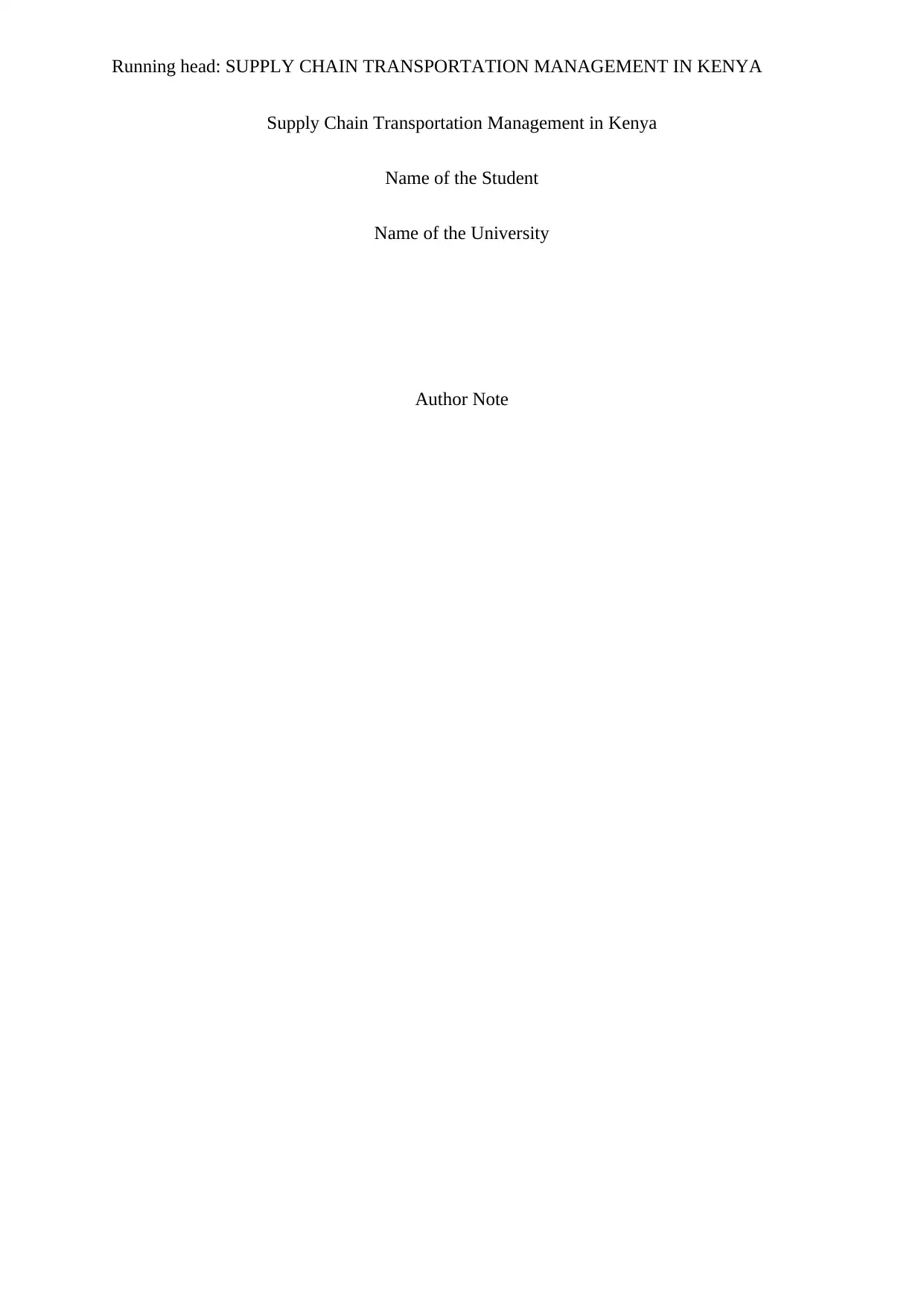
Running head: SUPPLY CHAIN TRANSPORTATION MANAGEMENT IN KENYA
Supply Chain Transportation Management in Kenya
Name of the Student
Name of the University
Author Note
Supply Chain Transportation Management in Kenya
Name of the Student
Name of the University
Author Note
Paraphrase This Document
Need a fresh take? Get an instant paraphrase of this document with our AI Paraphraser
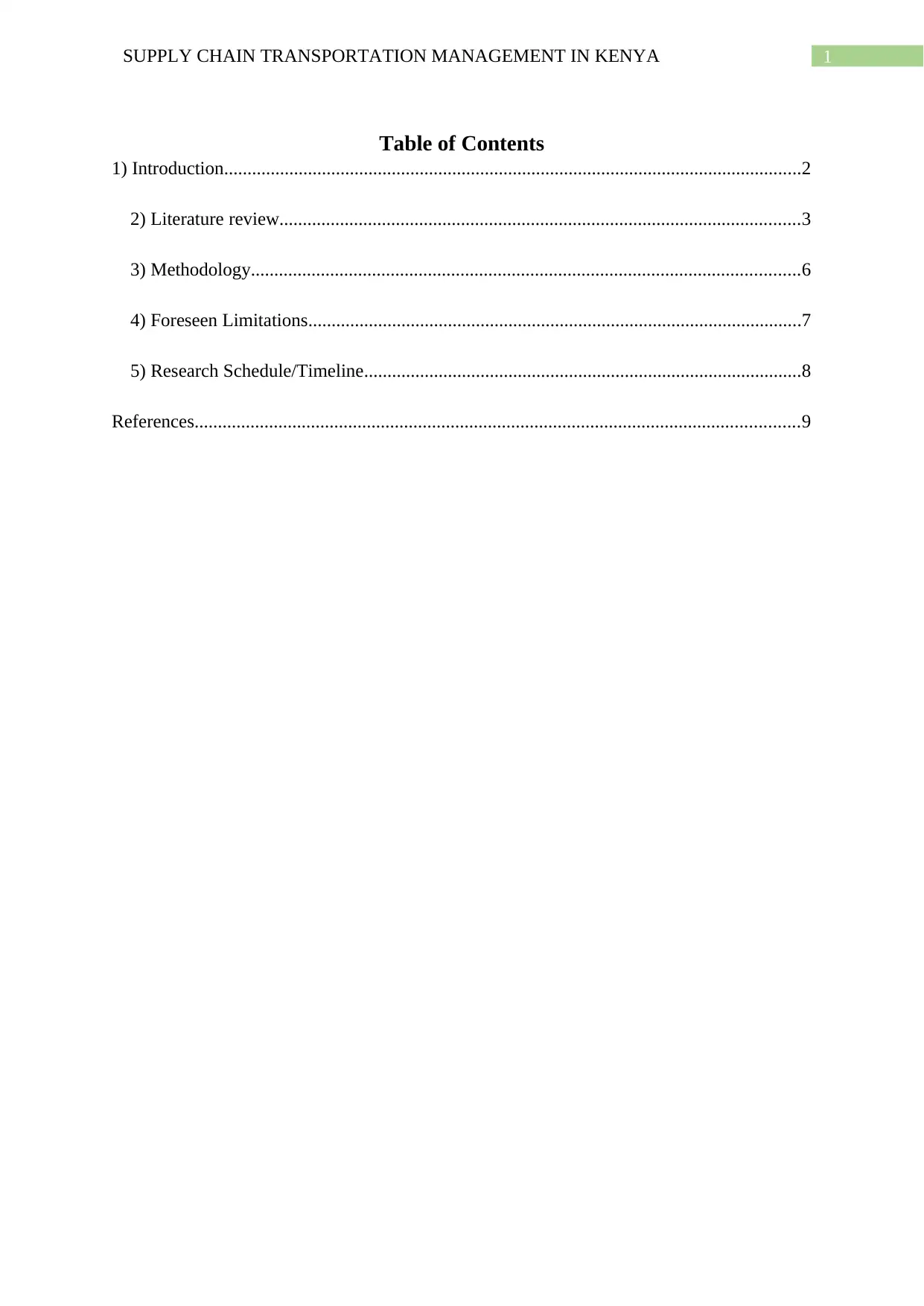
1SUPPLY CHAIN TRANSPORTATION MANAGEMENT IN KENYA
Table of Contents
1) Introduction............................................................................................................................2
2) Literature review................................................................................................................3
3) Methodology......................................................................................................................6
4) Foreseen Limitations..........................................................................................................7
5) Research Schedule/Timeline..............................................................................................8
References..................................................................................................................................9
Table of Contents
1) Introduction............................................................................................................................2
2) Literature review................................................................................................................3
3) Methodology......................................................................................................................6
4) Foreseen Limitations..........................................................................................................7
5) Research Schedule/Timeline..............................................................................................8
References..................................................................................................................................9
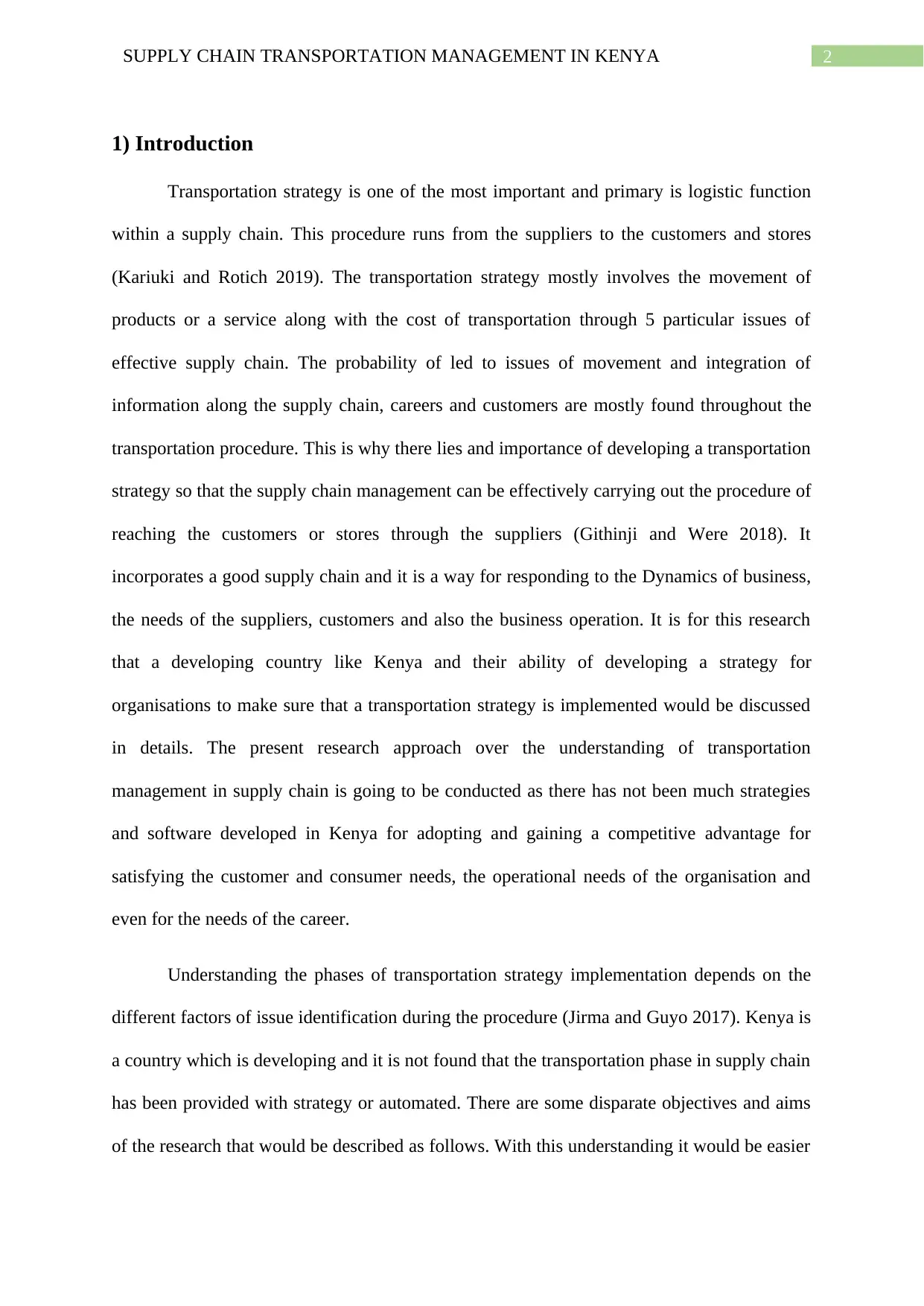
2SUPPLY CHAIN TRANSPORTATION MANAGEMENT IN KENYA
1) Introduction
Transportation strategy is one of the most important and primary is logistic function
within a supply chain. This procedure runs from the suppliers to the customers and stores
(Kariuki and Rotich 2019). The transportation strategy mostly involves the movement of
products or a service along with the cost of transportation through 5 particular issues of
effective supply chain. The probability of led to issues of movement and integration of
information along the supply chain, careers and customers are mostly found throughout the
transportation procedure. This is why there lies and importance of developing a transportation
strategy so that the supply chain management can be effectively carrying out the procedure of
reaching the customers or stores through the suppliers (Githinji and Were 2018). It
incorporates a good supply chain and it is a way for responding to the Dynamics of business,
the needs of the suppliers, customers and also the business operation. It is for this research
that a developing country like Kenya and their ability of developing a strategy for
organisations to make sure that a transportation strategy is implemented would be discussed
in details. The present research approach over the understanding of transportation
management in supply chain is going to be conducted as there has not been much strategies
and software developed in Kenya for adopting and gaining a competitive advantage for
satisfying the customer and consumer needs, the operational needs of the organisation and
even for the needs of the career.
Understanding the phases of transportation strategy implementation depends on the
different factors of issue identification during the procedure (Jirma and Guyo 2017). Kenya is
a country which is developing and it is not found that the transportation phase in supply chain
has been provided with strategy or automated. There are some disparate objectives and aims
of the research that would be described as follows. With this understanding it would be easier
1) Introduction
Transportation strategy is one of the most important and primary is logistic function
within a supply chain. This procedure runs from the suppliers to the customers and stores
(Kariuki and Rotich 2019). The transportation strategy mostly involves the movement of
products or a service along with the cost of transportation through 5 particular issues of
effective supply chain. The probability of led to issues of movement and integration of
information along the supply chain, careers and customers are mostly found throughout the
transportation procedure. This is why there lies and importance of developing a transportation
strategy so that the supply chain management can be effectively carrying out the procedure of
reaching the customers or stores through the suppliers (Githinji and Were 2018). It
incorporates a good supply chain and it is a way for responding to the Dynamics of business,
the needs of the suppliers, customers and also the business operation. It is for this research
that a developing country like Kenya and their ability of developing a strategy for
organisations to make sure that a transportation strategy is implemented would be discussed
in details. The present research approach over the understanding of transportation
management in supply chain is going to be conducted as there has not been much strategies
and software developed in Kenya for adopting and gaining a competitive advantage for
satisfying the customer and consumer needs, the operational needs of the organisation and
even for the needs of the career.
Understanding the phases of transportation strategy implementation depends on the
different factors of issue identification during the procedure (Jirma and Guyo 2017). Kenya is
a country which is developing and it is not found that the transportation phase in supply chain
has been provided with strategy or automated. There are some disparate objectives and aims
of the research that would be described as follows. With this understanding it would be easier
You're viewing a preview
Unlock full access by subscribing today!
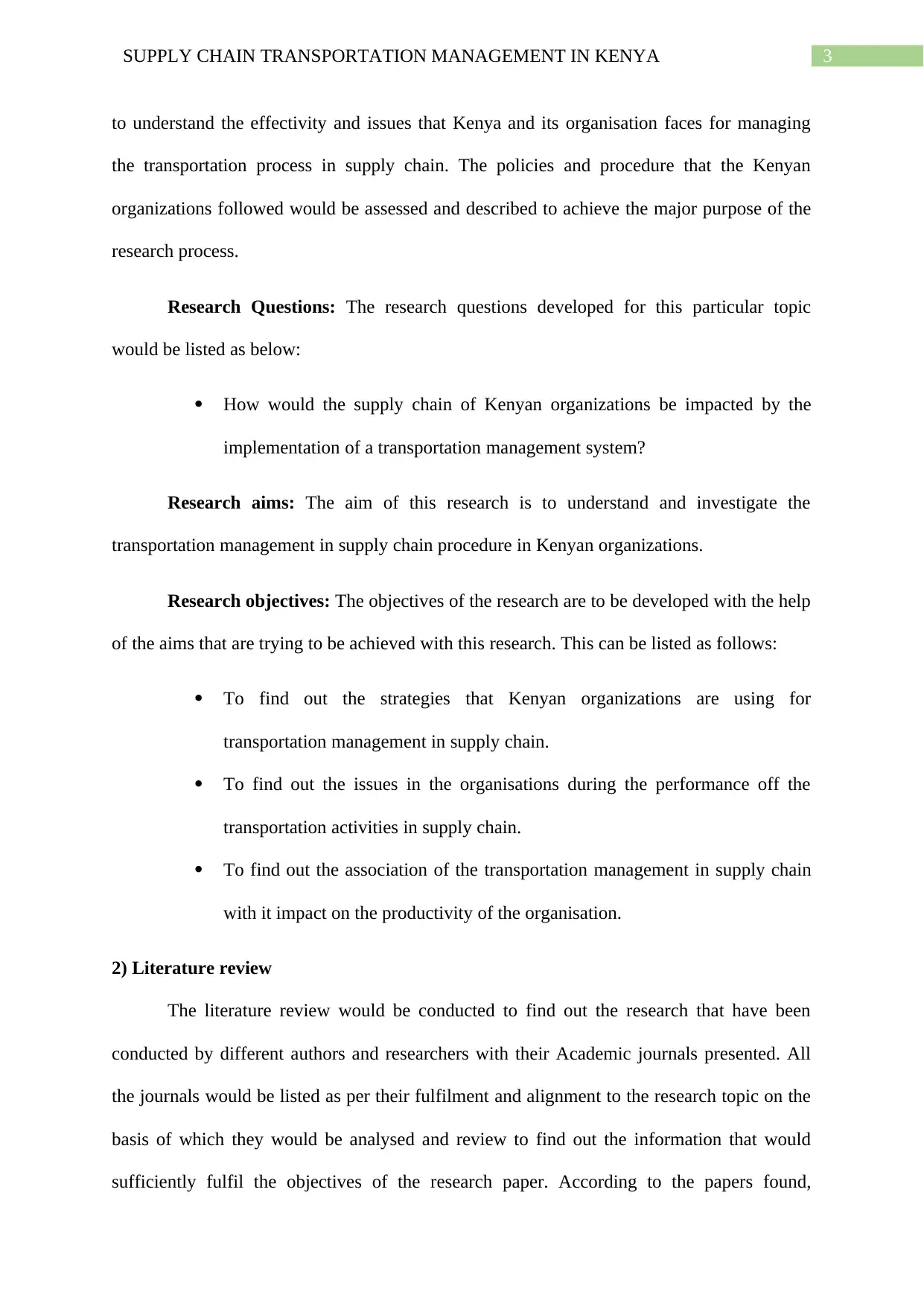
3SUPPLY CHAIN TRANSPORTATION MANAGEMENT IN KENYA
to understand the effectivity and issues that Kenya and its organisation faces for managing
the transportation process in supply chain. The policies and procedure that the Kenyan
organizations followed would be assessed and described to achieve the major purpose of the
research process.
Research Questions: The research questions developed for this particular topic
would be listed as below:
How would the supply chain of Kenyan organizations be impacted by the
implementation of a transportation management system?
Research aims: The aim of this research is to understand and investigate the
transportation management in supply chain procedure in Kenyan organizations.
Research objectives: The objectives of the research are to be developed with the help
of the aims that are trying to be achieved with this research. This can be listed as follows:
To find out the strategies that Kenyan organizations are using for
transportation management in supply chain.
To find out the issues in the organisations during the performance off the
transportation activities in supply chain.
To find out the association of the transportation management in supply chain
with it impact on the productivity of the organisation.
2) Literature review
The literature review would be conducted to find out the research that have been
conducted by different authors and researchers with their Academic journals presented. All
the journals would be listed as per their fulfilment and alignment to the research topic on the
basis of which they would be analysed and review to find out the information that would
sufficiently fulfil the objectives of the research paper. According to the papers found,
to understand the effectivity and issues that Kenya and its organisation faces for managing
the transportation process in supply chain. The policies and procedure that the Kenyan
organizations followed would be assessed and described to achieve the major purpose of the
research process.
Research Questions: The research questions developed for this particular topic
would be listed as below:
How would the supply chain of Kenyan organizations be impacted by the
implementation of a transportation management system?
Research aims: The aim of this research is to understand and investigate the
transportation management in supply chain procedure in Kenyan organizations.
Research objectives: The objectives of the research are to be developed with the help
of the aims that are trying to be achieved with this research. This can be listed as follows:
To find out the strategies that Kenyan organizations are using for
transportation management in supply chain.
To find out the issues in the organisations during the performance off the
transportation activities in supply chain.
To find out the association of the transportation management in supply chain
with it impact on the productivity of the organisation.
2) Literature review
The literature review would be conducted to find out the research that have been
conducted by different authors and researchers with their Academic journals presented. All
the journals would be listed as per their fulfilment and alignment to the research topic on the
basis of which they would be analysed and review to find out the information that would
sufficiently fulfil the objectives of the research paper. According to the papers found,
Paraphrase This Document
Need a fresh take? Get an instant paraphrase of this document with our AI Paraphraser
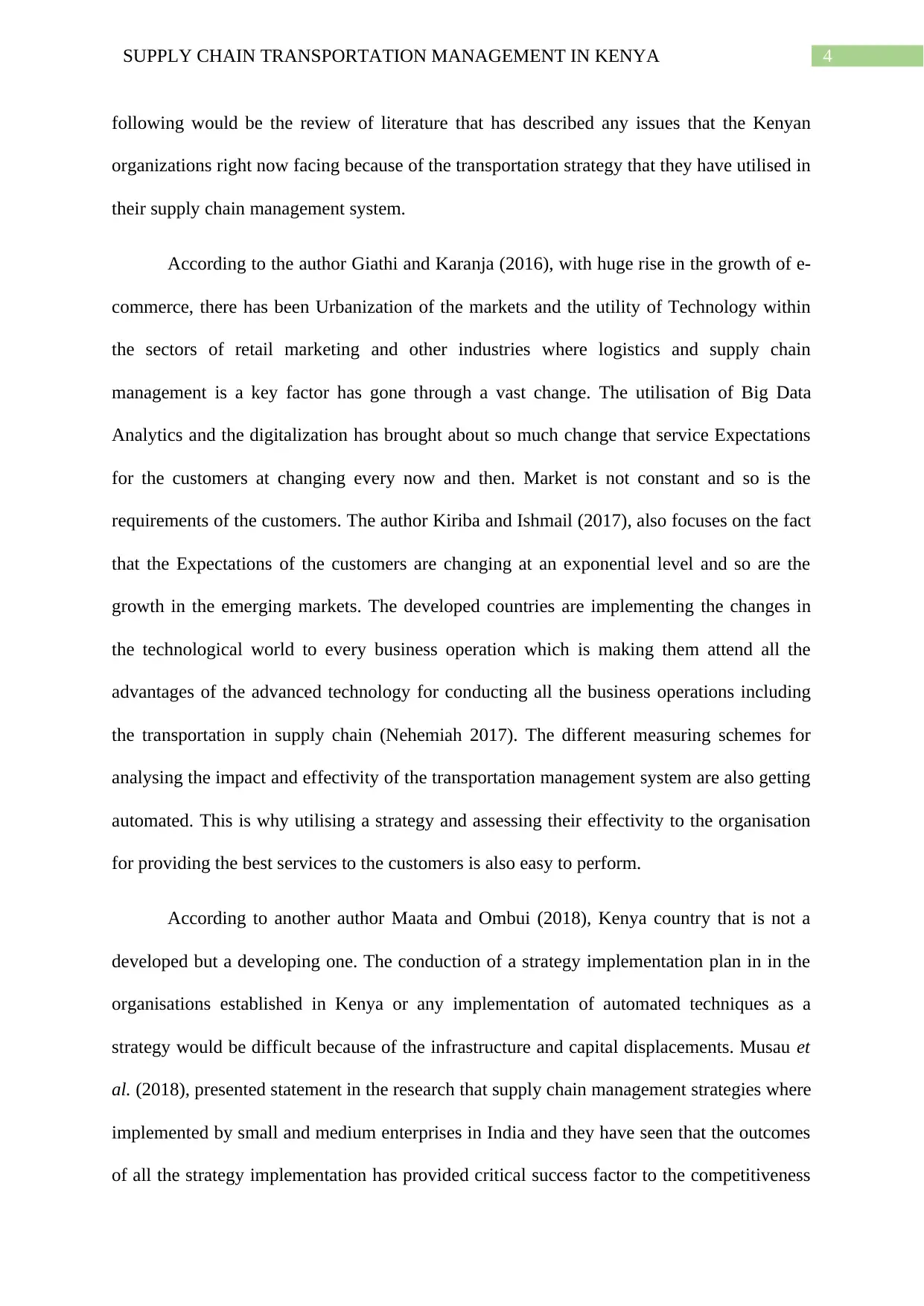
4SUPPLY CHAIN TRANSPORTATION MANAGEMENT IN KENYA
following would be the review of literature that has described any issues that the Kenyan
organizations right now facing because of the transportation strategy that they have utilised in
their supply chain management system.
According to the author Giathi and Karanja (2016), with huge rise in the growth of e-
commerce, there has been Urbanization of the markets and the utility of Technology within
the sectors of retail marketing and other industries where logistics and supply chain
management is a key factor has gone through a vast change. The utilisation of Big Data
Analytics and the digitalization has brought about so much change that service Expectations
for the customers at changing every now and then. Market is not constant and so is the
requirements of the customers. The author Kiriba and Ishmail (2017), also focuses on the fact
that the Expectations of the customers are changing at an exponential level and so are the
growth in the emerging markets. The developed countries are implementing the changes in
the technological world to every business operation which is making them attend all the
advantages of the advanced technology for conducting all the business operations including
the transportation in supply chain (Nehemiah 2017). The different measuring schemes for
analysing the impact and effectivity of the transportation management system are also getting
automated. This is why utilising a strategy and assessing their effectivity to the organisation
for providing the best services to the customers is also easy to perform.
According to another author Maata and Ombui (2018), Kenya country that is not a
developed but a developing one. The conduction of a strategy implementation plan in in the
organisations established in Kenya or any implementation of automated techniques as a
strategy would be difficult because of the infrastructure and capital displacements. Musau et
al. (2018), presented statement in the research that supply chain management strategies where
implemented by small and medium enterprises in India and they have seen that the outcomes
of all the strategy implementation has provided critical success factor to the competitiveness
following would be the review of literature that has described any issues that the Kenyan
organizations right now facing because of the transportation strategy that they have utilised in
their supply chain management system.
According to the author Giathi and Karanja (2016), with huge rise in the growth of e-
commerce, there has been Urbanization of the markets and the utility of Technology within
the sectors of retail marketing and other industries where logistics and supply chain
management is a key factor has gone through a vast change. The utilisation of Big Data
Analytics and the digitalization has brought about so much change that service Expectations
for the customers at changing every now and then. Market is not constant and so is the
requirements of the customers. The author Kiriba and Ishmail (2017), also focuses on the fact
that the Expectations of the customers are changing at an exponential level and so are the
growth in the emerging markets. The developed countries are implementing the changes in
the technological world to every business operation which is making them attend all the
advantages of the advanced technology for conducting all the business operations including
the transportation in supply chain (Nehemiah 2017). The different measuring schemes for
analysing the impact and effectivity of the transportation management system are also getting
automated. This is why utilising a strategy and assessing their effectivity to the organisation
for providing the best services to the customers is also easy to perform.
According to another author Maata and Ombui (2018), Kenya country that is not a
developed but a developing one. The conduction of a strategy implementation plan in in the
organisations established in Kenya or any implementation of automated techniques as a
strategy would be difficult because of the infrastructure and capital displacements. Musau et
al. (2018), presented statement in the research that supply chain management strategies where
implemented by small and medium enterprises in India and they have seen that the outcomes
of all the strategy implementation has provided critical success factor to the competitiveness
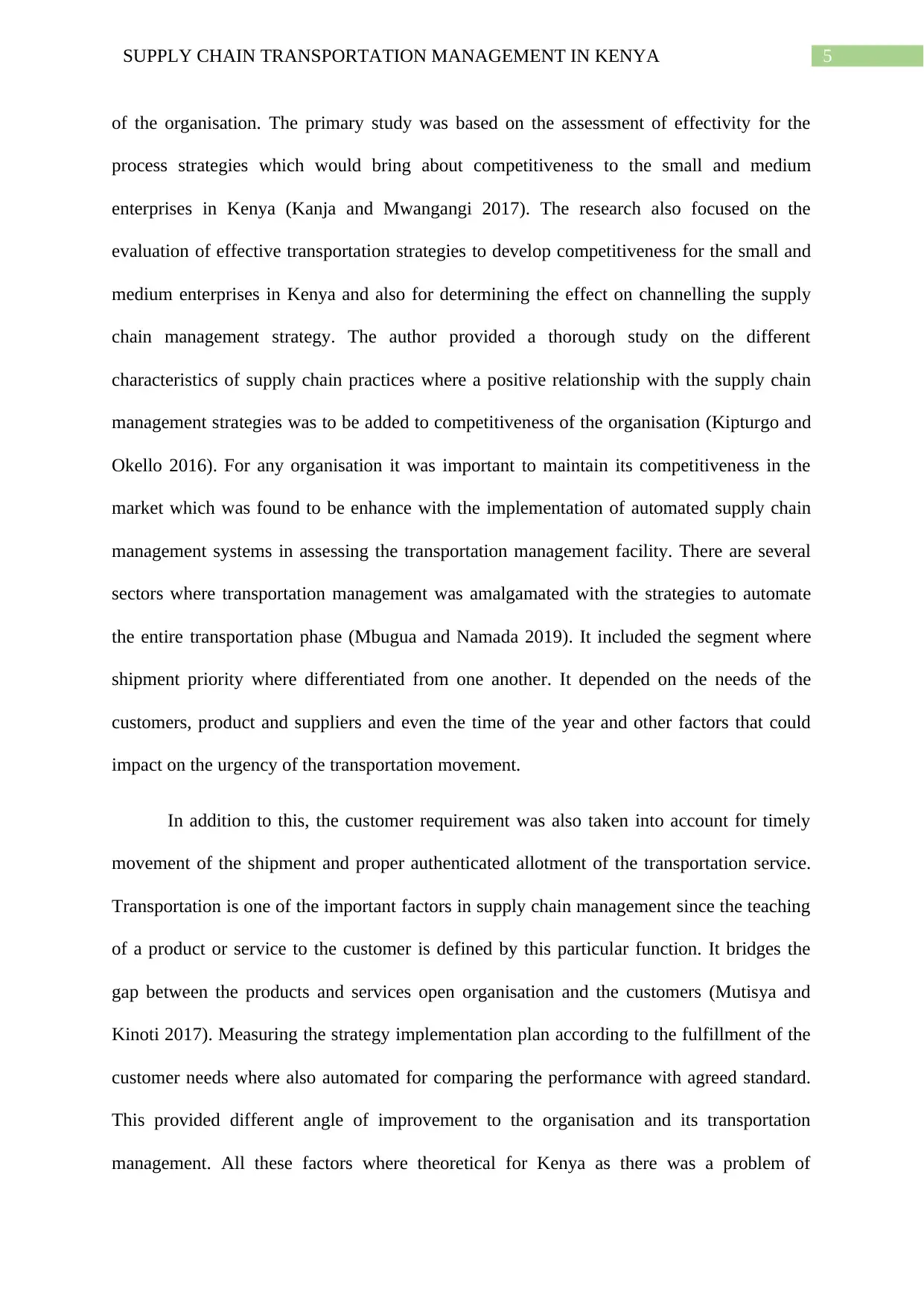
5SUPPLY CHAIN TRANSPORTATION MANAGEMENT IN KENYA
of the organisation. The primary study was based on the assessment of effectivity for the
process strategies which would bring about competitiveness to the small and medium
enterprises in Kenya (Kanja and Mwangangi 2017). The research also focused on the
evaluation of effective transportation strategies to develop competitiveness for the small and
medium enterprises in Kenya and also for determining the effect on channelling the supply
chain management strategy. The author provided a thorough study on the different
characteristics of supply chain practices where a positive relationship with the supply chain
management strategies was to be added to competitiveness of the organisation (Kipturgo and
Okello 2016). For any organisation it was important to maintain its competitiveness in the
market which was found to be enhance with the implementation of automated supply chain
management systems in assessing the transportation management facility. There are several
sectors where transportation management was amalgamated with the strategies to automate
the entire transportation phase (Mbugua and Namada 2019). It included the segment where
shipment priority where differentiated from one another. It depended on the needs of the
customers, product and suppliers and even the time of the year and other factors that could
impact on the urgency of the transportation movement.
In addition to this, the customer requirement was also taken into account for timely
movement of the shipment and proper authenticated allotment of the transportation service.
Transportation is one of the important factors in supply chain management since the teaching
of a product or service to the customer is defined by this particular function. It bridges the
gap between the products and services open organisation and the customers (Mutisya and
Kinoti 2017). Measuring the strategy implementation plan according to the fulfillment of the
customer needs where also automated for comparing the performance with agreed standard.
This provided different angle of improvement to the organisation and its transportation
management. All these factors where theoretical for Kenya as there was a problem of
of the organisation. The primary study was based on the assessment of effectivity for the
process strategies which would bring about competitiveness to the small and medium
enterprises in Kenya (Kanja and Mwangangi 2017). The research also focused on the
evaluation of effective transportation strategies to develop competitiveness for the small and
medium enterprises in Kenya and also for determining the effect on channelling the supply
chain management strategy. The author provided a thorough study on the different
characteristics of supply chain practices where a positive relationship with the supply chain
management strategies was to be added to competitiveness of the organisation (Kipturgo and
Okello 2016). For any organisation it was important to maintain its competitiveness in the
market which was found to be enhance with the implementation of automated supply chain
management systems in assessing the transportation management facility. There are several
sectors where transportation management was amalgamated with the strategies to automate
the entire transportation phase (Mbugua and Namada 2019). It included the segment where
shipment priority where differentiated from one another. It depended on the needs of the
customers, product and suppliers and even the time of the year and other factors that could
impact on the urgency of the transportation movement.
In addition to this, the customer requirement was also taken into account for timely
movement of the shipment and proper authenticated allotment of the transportation service.
Transportation is one of the important factors in supply chain management since the teaching
of a product or service to the customer is defined by this particular function. It bridges the
gap between the products and services open organisation and the customers (Mutisya and
Kinoti 2017). Measuring the strategy implementation plan according to the fulfillment of the
customer needs where also automated for comparing the performance with agreed standard.
This provided different angle of improvement to the organisation and its transportation
management. All these factors where theoretical for Kenya as there was a problem of
You're viewing a preview
Unlock full access by subscribing today!
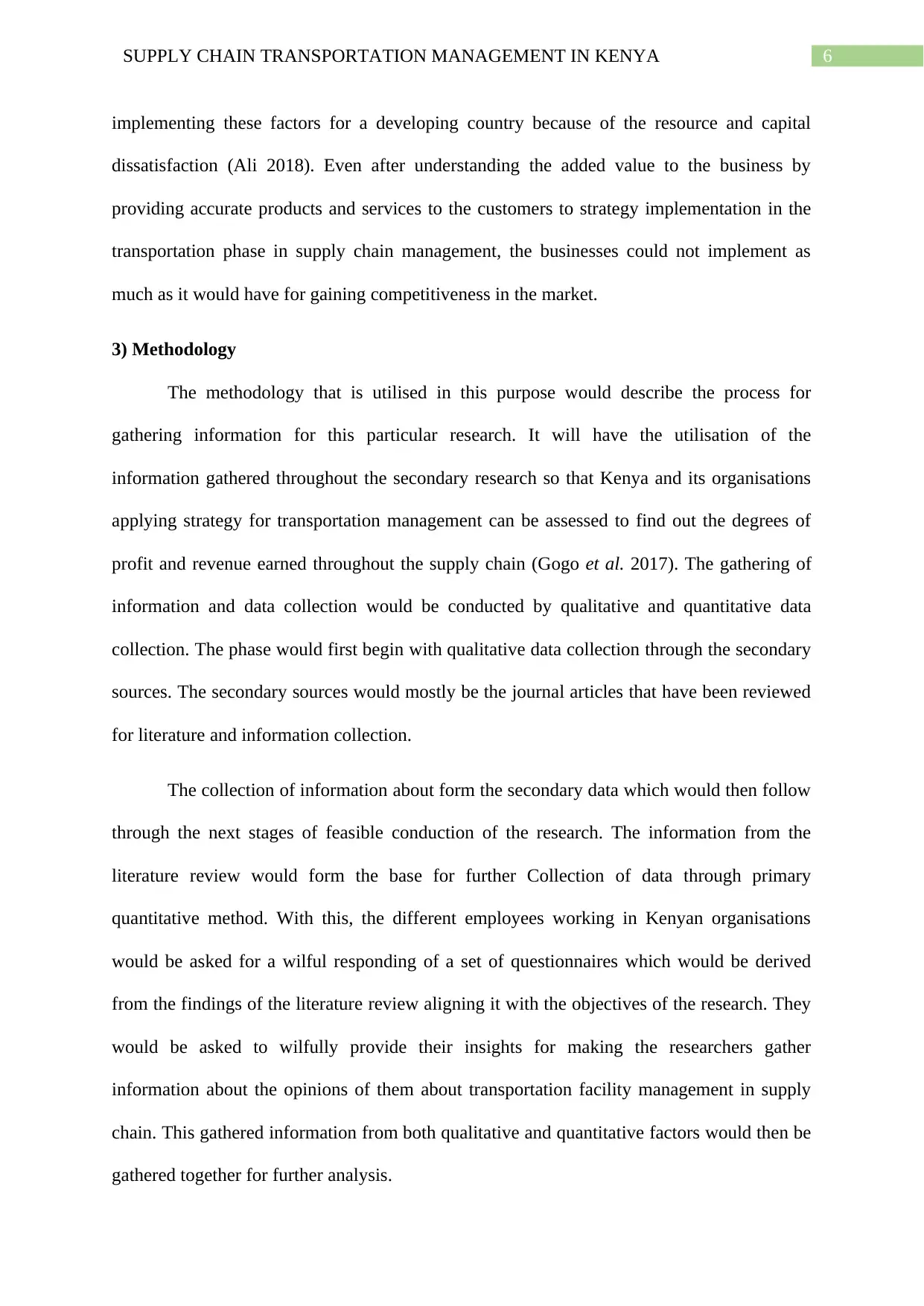
6SUPPLY CHAIN TRANSPORTATION MANAGEMENT IN KENYA
implementing these factors for a developing country because of the resource and capital
dissatisfaction (Ali 2018). Even after understanding the added value to the business by
providing accurate products and services to the customers to strategy implementation in the
transportation phase in supply chain management, the businesses could not implement as
much as it would have for gaining competitiveness in the market.
3) Methodology
The methodology that is utilised in this purpose would describe the process for
gathering information for this particular research. It will have the utilisation of the
information gathered throughout the secondary research so that Kenya and its organisations
applying strategy for transportation management can be assessed to find out the degrees of
profit and revenue earned throughout the supply chain (Gogo et al. 2017). The gathering of
information and data collection would be conducted by qualitative and quantitative data
collection. The phase would first begin with qualitative data collection through the secondary
sources. The secondary sources would mostly be the journal articles that have been reviewed
for literature and information collection.
The collection of information about form the secondary data which would then follow
through the next stages of feasible conduction of the research. The information from the
literature review would form the base for further Collection of data through primary
quantitative method. With this, the different employees working in Kenyan organisations
would be asked for a wilful responding of a set of questionnaires which would be derived
from the findings of the literature review aligning it with the objectives of the research. They
would be asked to wilfully provide their insights for making the researchers gather
information about the opinions of them about transportation facility management in supply
chain. This gathered information from both qualitative and quantitative factors would then be
gathered together for further analysis.
implementing these factors for a developing country because of the resource and capital
dissatisfaction (Ali 2018). Even after understanding the added value to the business by
providing accurate products and services to the customers to strategy implementation in the
transportation phase in supply chain management, the businesses could not implement as
much as it would have for gaining competitiveness in the market.
3) Methodology
The methodology that is utilised in this purpose would describe the process for
gathering information for this particular research. It will have the utilisation of the
information gathered throughout the secondary research so that Kenya and its organisations
applying strategy for transportation management can be assessed to find out the degrees of
profit and revenue earned throughout the supply chain (Gogo et al. 2017). The gathering of
information and data collection would be conducted by qualitative and quantitative data
collection. The phase would first begin with qualitative data collection through the secondary
sources. The secondary sources would mostly be the journal articles that have been reviewed
for literature and information collection.
The collection of information about form the secondary data which would then follow
through the next stages of feasible conduction of the research. The information from the
literature review would form the base for further Collection of data through primary
quantitative method. With this, the different employees working in Kenyan organisations
would be asked for a wilful responding of a set of questionnaires which would be derived
from the findings of the literature review aligning it with the objectives of the research. They
would be asked to wilfully provide their insights for making the researchers gather
information about the opinions of them about transportation facility management in supply
chain. This gathered information from both qualitative and quantitative factors would then be
gathered together for further analysis.
Paraphrase This Document
Need a fresh take? Get an instant paraphrase of this document with our AI Paraphraser
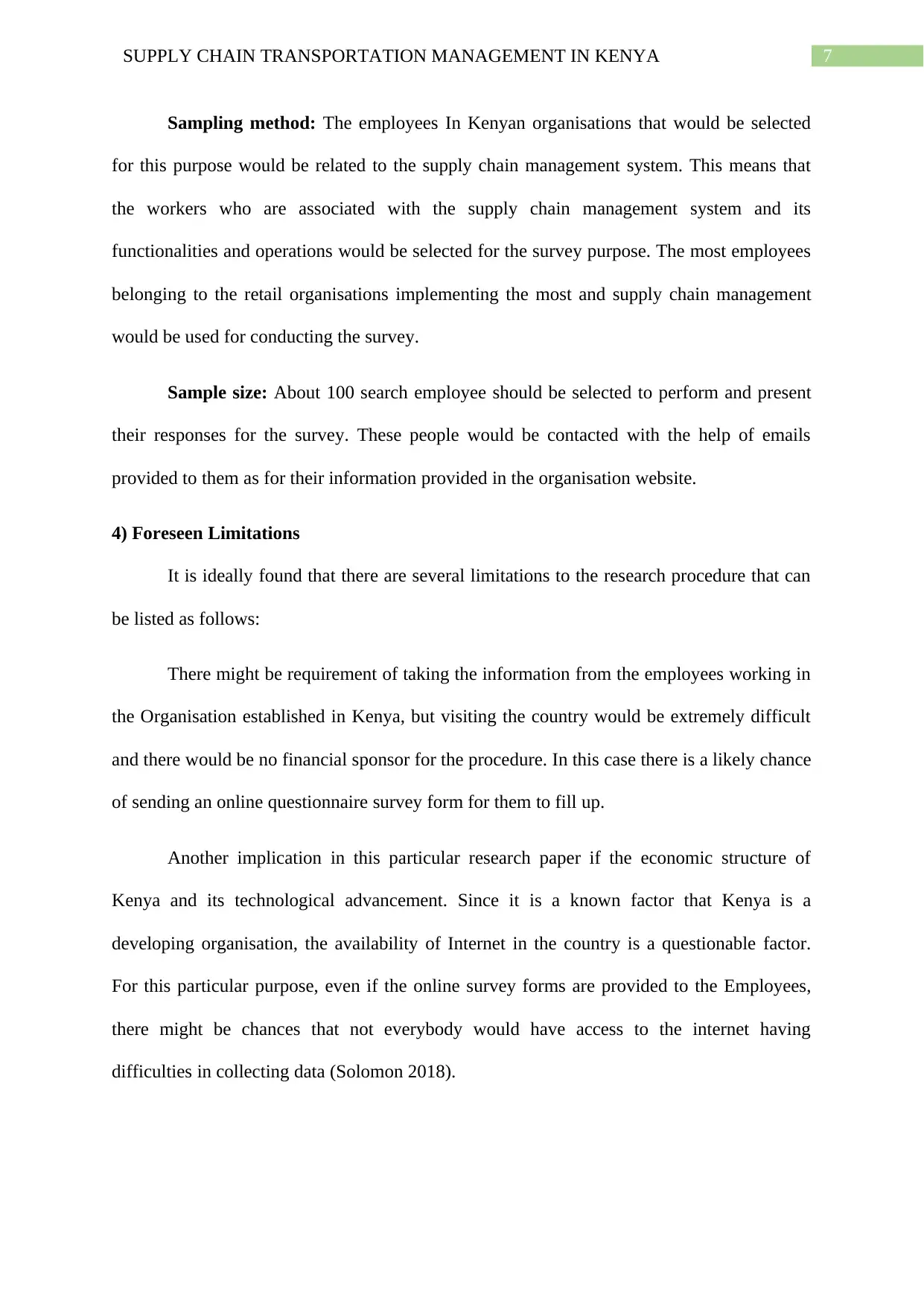
7SUPPLY CHAIN TRANSPORTATION MANAGEMENT IN KENYA
Sampling method: The employees In Kenyan organisations that would be selected
for this purpose would be related to the supply chain management system. This means that
the workers who are associated with the supply chain management system and its
functionalities and operations would be selected for the survey purpose. The most employees
belonging to the retail organisations implementing the most and supply chain management
would be used for conducting the survey.
Sample size: About 100 search employee should be selected to perform and present
their responses for the survey. These people would be contacted with the help of emails
provided to them as for their information provided in the organisation website.
4) Foreseen Limitations
It is ideally found that there are several limitations to the research procedure that can
be listed as follows:
There might be requirement of taking the information from the employees working in
the Organisation established in Kenya, but visiting the country would be extremely difficult
and there would be no financial sponsor for the procedure. In this case there is a likely chance
of sending an online questionnaire survey form for them to fill up.
Another implication in this particular research paper if the economic structure of
Kenya and its technological advancement. Since it is a known factor that Kenya is a
developing organisation, the availability of Internet in the country is a questionable factor.
For this particular purpose, even if the online survey forms are provided to the Employees,
there might be chances that not everybody would have access to the internet having
difficulties in collecting data (Solomon 2018).
Sampling method: The employees In Kenyan organisations that would be selected
for this purpose would be related to the supply chain management system. This means that
the workers who are associated with the supply chain management system and its
functionalities and operations would be selected for the survey purpose. The most employees
belonging to the retail organisations implementing the most and supply chain management
would be used for conducting the survey.
Sample size: About 100 search employee should be selected to perform and present
their responses for the survey. These people would be contacted with the help of emails
provided to them as for their information provided in the organisation website.
4) Foreseen Limitations
It is ideally found that there are several limitations to the research procedure that can
be listed as follows:
There might be requirement of taking the information from the employees working in
the Organisation established in Kenya, but visiting the country would be extremely difficult
and there would be no financial sponsor for the procedure. In this case there is a likely chance
of sending an online questionnaire survey form for them to fill up.
Another implication in this particular research paper if the economic structure of
Kenya and its technological advancement. Since it is a known factor that Kenya is a
developing organisation, the availability of Internet in the country is a questionable factor.
For this particular purpose, even if the online survey forms are provided to the Employees,
there might be chances that not everybody would have access to the internet having
difficulties in collecting data (Solomon 2018).
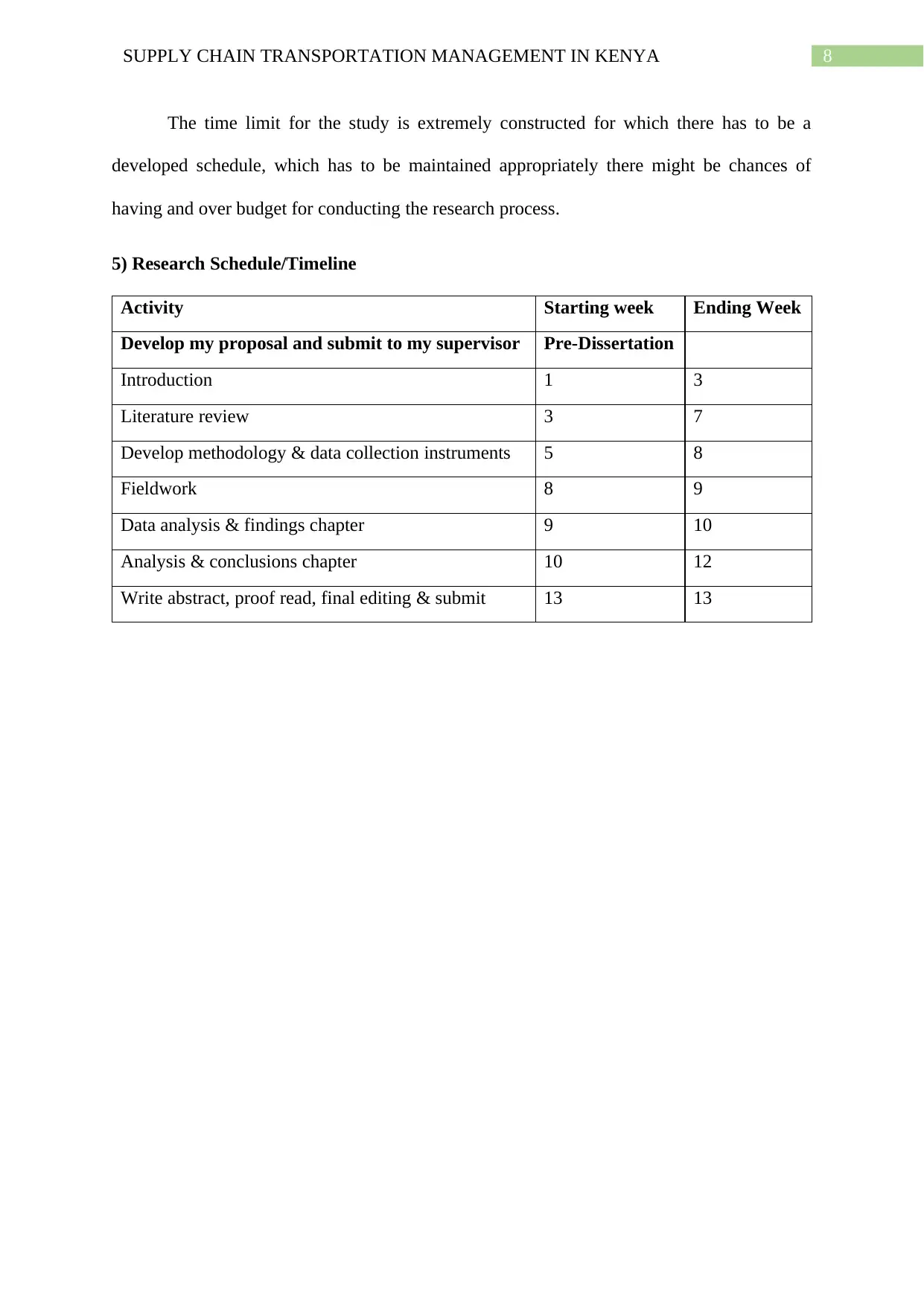
8SUPPLY CHAIN TRANSPORTATION MANAGEMENT IN KENYA
The time limit for the study is extremely constructed for which there has to be a
developed schedule, which has to be maintained appropriately there might be chances of
having and over budget for conducting the research process.
5) Research Schedule/Timeline
Activity Starting week Ending Week
Develop my proposal and submit to my supervisor Pre-Dissertation
Introduction 1 3
Literature review 3 7
Develop methodology & data collection instruments 5 8
Fieldwork 8 9
Data analysis & findings chapter 9 10
Analysis & conclusions chapter 10 12
Write abstract, proof read, final editing & submit 13 13
The time limit for the study is extremely constructed for which there has to be a
developed schedule, which has to be maintained appropriately there might be chances of
having and over budget for conducting the research process.
5) Research Schedule/Timeline
Activity Starting week Ending Week
Develop my proposal and submit to my supervisor Pre-Dissertation
Introduction 1 3
Literature review 3 7
Develop methodology & data collection instruments 5 8
Fieldwork 8 9
Data analysis & findings chapter 9 10
Analysis & conclusions chapter 10 12
Write abstract, proof read, final editing & submit 13 13
You're viewing a preview
Unlock full access by subscribing today!
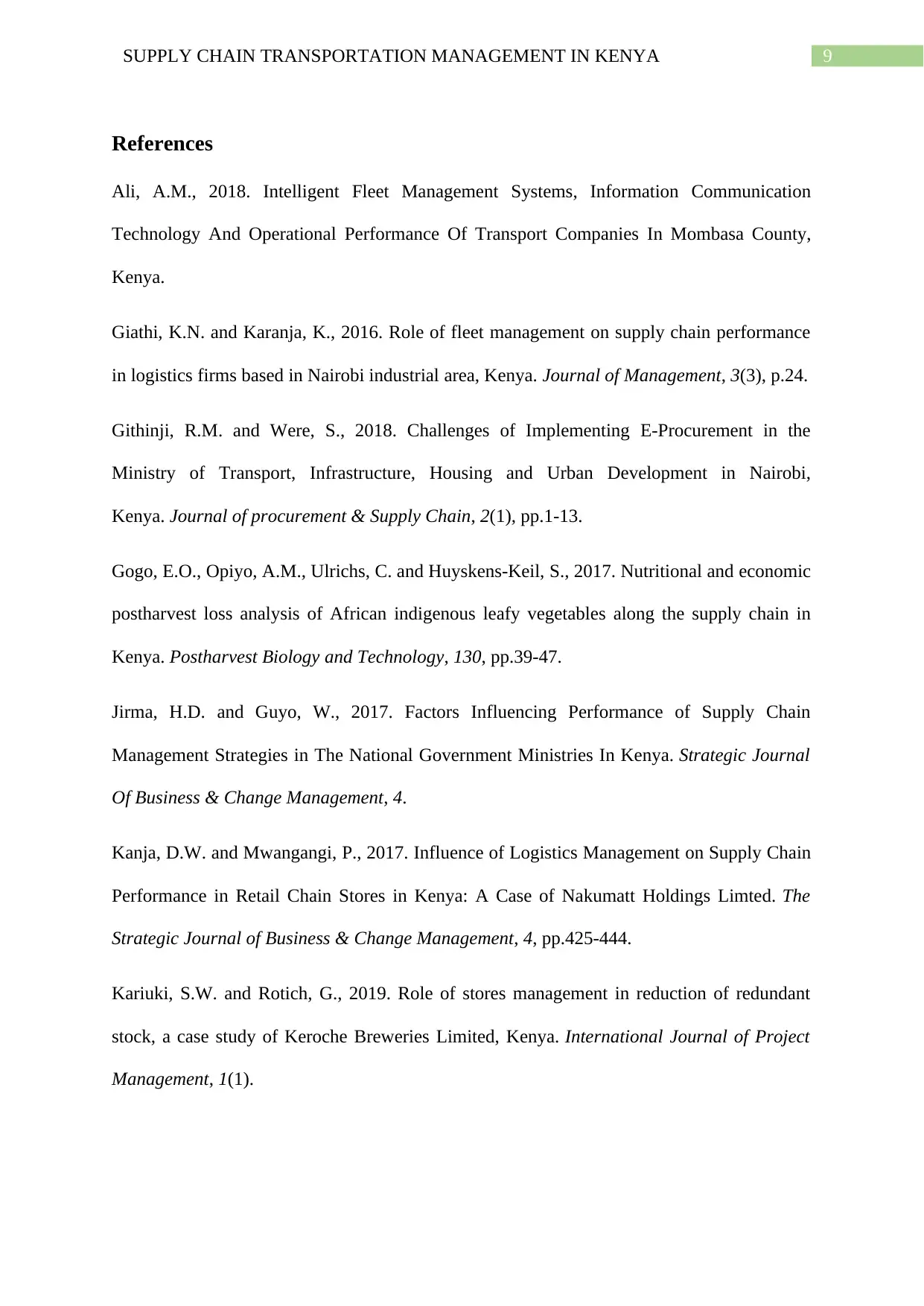
9SUPPLY CHAIN TRANSPORTATION MANAGEMENT IN KENYA
References
Ali, A.M., 2018. Intelligent Fleet Management Systems, Information Communication
Technology And Operational Performance Of Transport Companies In Mombasa County,
Kenya.
Giathi, K.N. and Karanja, K., 2016. Role of fleet management on supply chain performance
in logistics firms based in Nairobi industrial area, Kenya. Journal of Management, 3(3), p.24.
Githinji, R.M. and Were, S., 2018. Challenges of Implementing E-Procurement in the
Ministry of Transport, Infrastructure, Housing and Urban Development in Nairobi,
Kenya. Journal of procurement & Supply Chain, 2(1), pp.1-13.
Gogo, E.O., Opiyo, A.M., Ulrichs, C. and Huyskens-Keil, S., 2017. Nutritional and economic
postharvest loss analysis of African indigenous leafy vegetables along the supply chain in
Kenya. Postharvest Biology and Technology, 130, pp.39-47.
Jirma, H.D. and Guyo, W., 2017. Factors Influencing Performance of Supply Chain
Management Strategies in The National Government Ministries In Kenya. Strategic Journal
Of Business & Change Management, 4.
Kanja, D.W. and Mwangangi, P., 2017. Influence of Logistics Management on Supply Chain
Performance in Retail Chain Stores in Kenya: A Case of Nakumatt Holdings Limted. The
Strategic Journal of Business & Change Management, 4, pp.425-444.
Kariuki, S.W. and Rotich, G., 2019. Role of stores management in reduction of redundant
stock, a case study of Keroche Breweries Limited, Kenya. International Journal of Project
Management, 1(1).
References
Ali, A.M., 2018. Intelligent Fleet Management Systems, Information Communication
Technology And Operational Performance Of Transport Companies In Mombasa County,
Kenya.
Giathi, K.N. and Karanja, K., 2016. Role of fleet management on supply chain performance
in logistics firms based in Nairobi industrial area, Kenya. Journal of Management, 3(3), p.24.
Githinji, R.M. and Were, S., 2018. Challenges of Implementing E-Procurement in the
Ministry of Transport, Infrastructure, Housing and Urban Development in Nairobi,
Kenya. Journal of procurement & Supply Chain, 2(1), pp.1-13.
Gogo, E.O., Opiyo, A.M., Ulrichs, C. and Huyskens-Keil, S., 2017. Nutritional and economic
postharvest loss analysis of African indigenous leafy vegetables along the supply chain in
Kenya. Postharvest Biology and Technology, 130, pp.39-47.
Jirma, H.D. and Guyo, W., 2017. Factors Influencing Performance of Supply Chain
Management Strategies in The National Government Ministries In Kenya. Strategic Journal
Of Business & Change Management, 4.
Kanja, D.W. and Mwangangi, P., 2017. Influence of Logistics Management on Supply Chain
Performance in Retail Chain Stores in Kenya: A Case of Nakumatt Holdings Limted. The
Strategic Journal of Business & Change Management, 4, pp.425-444.
Kariuki, S.W. and Rotich, G., 2019. Role of stores management in reduction of redundant
stock, a case study of Keroche Breweries Limited, Kenya. International Journal of Project
Management, 1(1).
Paraphrase This Document
Need a fresh take? Get an instant paraphrase of this document with our AI Paraphraser
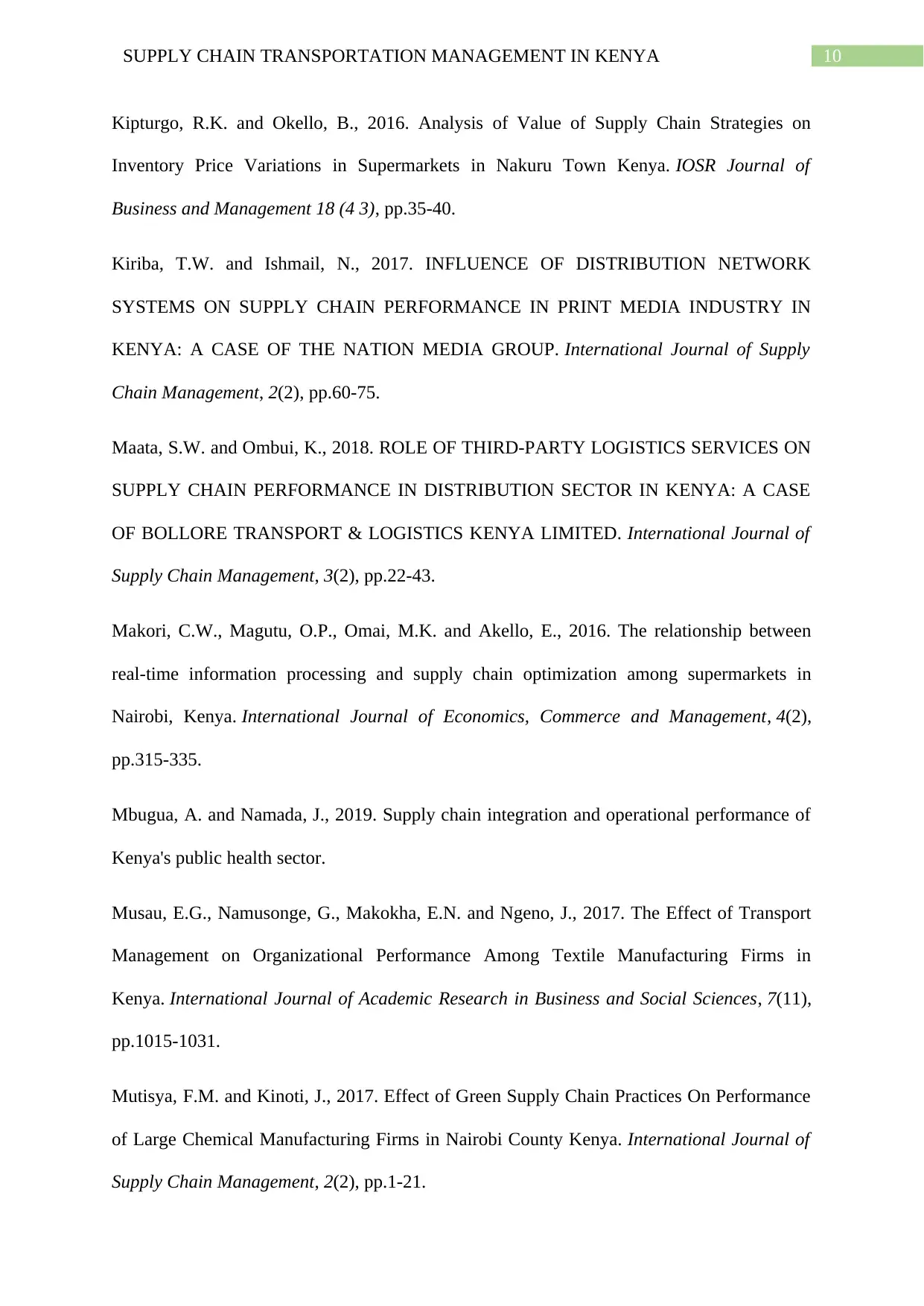
10SUPPLY CHAIN TRANSPORTATION MANAGEMENT IN KENYA
Kipturgo, R.K. and Okello, B., 2016. Analysis of Value of Supply Chain Strategies on
Inventory Price Variations in Supermarkets in Nakuru Town Kenya. IOSR Journal of
Business and Management 18 (4 3), pp.35-40.
Kiriba, T.W. and Ishmail, N., 2017. INFLUENCE OF DISTRIBUTION NETWORK
SYSTEMS ON SUPPLY CHAIN PERFORMANCE IN PRINT MEDIA INDUSTRY IN
KENYA: A CASE OF THE NATION MEDIA GROUP. International Journal of Supply
Chain Management, 2(2), pp.60-75.
Maata, S.W. and Ombui, K., 2018. ROLE OF THIRD-PARTY LOGISTICS SERVICES ON
SUPPLY CHAIN PERFORMANCE IN DISTRIBUTION SECTOR IN KENYA: A CASE
OF BOLLORE TRANSPORT & LOGISTICS KENYA LIMITED. International Journal of
Supply Chain Management, 3(2), pp.22-43.
Makori, C.W., Magutu, O.P., Omai, M.K. and Akello, E., 2016. The relationship between
real-time information processing and supply chain optimization among supermarkets in
Nairobi, Kenya. International Journal of Economics, Commerce and Management, 4(2),
pp.315-335.
Mbugua, A. and Namada, J., 2019. Supply chain integration and operational performance of
Kenya's public health sector.
Musau, E.G., Namusonge, G., Makokha, E.N. and Ngeno, J., 2017. The Effect of Transport
Management on Organizational Performance Among Textile Manufacturing Firms in
Kenya. International Journal of Academic Research in Business and Social Sciences, 7(11),
pp.1015-1031.
Mutisya, F.M. and Kinoti, J., 2017. Effect of Green Supply Chain Practices On Performance
of Large Chemical Manufacturing Firms in Nairobi County Kenya. International Journal of
Supply Chain Management, 2(2), pp.1-21.
Kipturgo, R.K. and Okello, B., 2016. Analysis of Value of Supply Chain Strategies on
Inventory Price Variations in Supermarkets in Nakuru Town Kenya. IOSR Journal of
Business and Management 18 (4 3), pp.35-40.
Kiriba, T.W. and Ishmail, N., 2017. INFLUENCE OF DISTRIBUTION NETWORK
SYSTEMS ON SUPPLY CHAIN PERFORMANCE IN PRINT MEDIA INDUSTRY IN
KENYA: A CASE OF THE NATION MEDIA GROUP. International Journal of Supply
Chain Management, 2(2), pp.60-75.
Maata, S.W. and Ombui, K., 2018. ROLE OF THIRD-PARTY LOGISTICS SERVICES ON
SUPPLY CHAIN PERFORMANCE IN DISTRIBUTION SECTOR IN KENYA: A CASE
OF BOLLORE TRANSPORT & LOGISTICS KENYA LIMITED. International Journal of
Supply Chain Management, 3(2), pp.22-43.
Makori, C.W., Magutu, O.P., Omai, M.K. and Akello, E., 2016. The relationship between
real-time information processing and supply chain optimization among supermarkets in
Nairobi, Kenya. International Journal of Economics, Commerce and Management, 4(2),
pp.315-335.
Mbugua, A. and Namada, J., 2019. Supply chain integration and operational performance of
Kenya's public health sector.
Musau, E.G., Namusonge, G., Makokha, E.N. and Ngeno, J., 2017. The Effect of Transport
Management on Organizational Performance Among Textile Manufacturing Firms in
Kenya. International Journal of Academic Research in Business and Social Sciences, 7(11),
pp.1015-1031.
Mutisya, F.M. and Kinoti, J., 2017. Effect of Green Supply Chain Practices On Performance
of Large Chemical Manufacturing Firms in Nairobi County Kenya. International Journal of
Supply Chain Management, 2(2), pp.1-21.

11SUPPLY CHAIN TRANSPORTATION MANAGEMENT IN KENYA
Nehemiah, W., 2017. Supply Chain Management Practices and Operational Performance of
SMEs in Nairobi County, Kenya. In Management Challenges in Different Types of African
Firms (pp. 95-111). Springer, Singapore.
Solomon, C.K., 2018. LOGISTICS MANAGEMENT PRACTICES AND
ORGANIZATIONALPERFORMANCEOF DAIRY FIRMS IN KENYA (Doctoral dissertation,
School of Business, University of Nairobi).
Nehemiah, W., 2017. Supply Chain Management Practices and Operational Performance of
SMEs in Nairobi County, Kenya. In Management Challenges in Different Types of African
Firms (pp. 95-111). Springer, Singapore.
Solomon, C.K., 2018. LOGISTICS MANAGEMENT PRACTICES AND
ORGANIZATIONALPERFORMANCEOF DAIRY FIRMS IN KENYA (Doctoral dissertation,
School of Business, University of Nairobi).
You're viewing a preview
Unlock full access by subscribing today!
1 out of 12
Related Documents
Your All-in-One AI-Powered Toolkit for Academic Success.
+13062052269
info@desklib.com
Available 24*7 on WhatsApp / Email
![[object Object]](/_next/static/media/star-bottom.7253800d.svg)
Unlock your academic potential
© 2024 | Zucol Services PVT LTD | All rights reserved.





